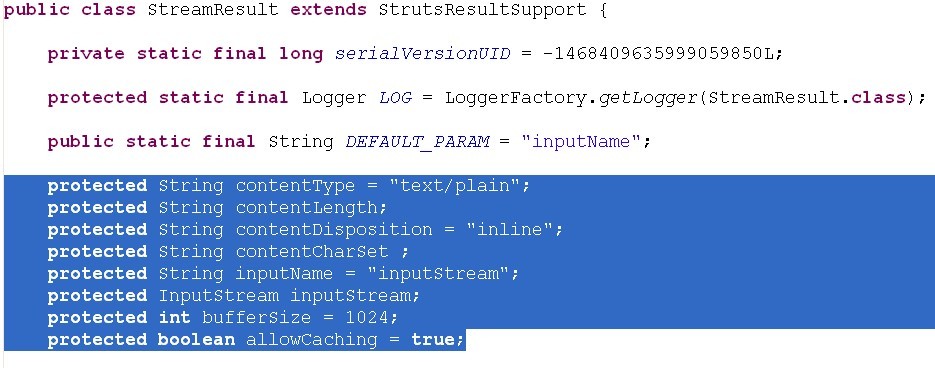Struts2总结---文件上传(单文件/多文件)、下载 (13)
来源:互联网 发布:iphone看小说软件 编辑:程序博客网 时间:2024/06/13 08:57
<一>简述:
Struts2的文件上传其实也是通过拦截器来实现的,只是该拦截器定义为默认拦截器了,所以不用自己去手工配置,<interceptor name="fileUpload" class="org.apache.struts2.interceptor.FileUploadInterceptor"/>
<二>指定用户上传文件的大小,有两种方式:
1)默认是在default.properties 文件的 struts.multipart.maxSize=2097152 键值指定为2097152 也就是2M,通过计算 2097152/(1024*1024) = 2 M
那我们可以改变其默认值,只要在src目录下,新建一个 struts.properties 文件,指定上传大小 如下:

一次上传只可以上传10M,不管一次上传多少个文件,按总和计算
2)在struts.xml文件中指定,如图:

其实name就对应struts.properties的键,value对应 值
注意:如果即在struts.properties设定文件上传大小,又在struts.xml 设定文件上传大小,则struts.properties的优先级高于struts.xml,一般在一处指定上传大小即可,推荐 struts.properties
<三>Struts2之单文件上传
1.fileupload.jsp
<%@ page language="java" import="java.util.*" pageEncoding="UTF-8"%> <% String path = request.getContextPath(); String basePath = request.getScheme()+"://"+request.getServerName()+":"+request.getServerPort()+path+"/"; %> <!DOCTYPE HTML PUBLIC "-//W3C//DTD HTML 4.01 Transitional//EN"> <html> <head> <base href="<%=basePath%>"> <title>My JSP 'fileupload.jsp' starting page</title> <meta http-equiv="pragma" content="no-cache"> <meta http-equiv="cache-control" content="no-cache"> <meta http-equiv="expires" content="0"> <meta http-equiv="keywords" content="keyword1,keyword2,keyword3"> <meta http-equiv="description" content="This is my page"> <!-- <link rel="stylesheet" type="text/css" href="styles.css"> --> </head> <body> <!-- enctype 默认是 application/x-www-form-urlencoded --> <form action="FileUpload2" enctype="multipart/form-data" method="post" > 用户名:<input type="text" name="usename"> <br/> 上传文件:<input type="file" name="file1"><br/> <input type="submit" value="提交"/> </form> </body> </html>
2.具体处理上传的 FileUpload.java
package com.struts2.fileupload; import java.io.File; import java.io.FileInputStream; import java.io.FileOutputStream; import java.io.InputStream; import java.io.OutputStream; import org.apache.struts2.ServletActionContext; import com.opensymphony.xwork2.ActionSupport; /** * 单个文件上传 * @author Administrator * 上传文件其实是上传了两份, * * 首先将上传的文件保存到 default.properties 文件中 struts.multipart.saveDir键指定的目录中 * 默认是空的 * 保存在 Tomcat 6.0\work\Catalina\localhost\struts2目录下以.tmp后缀名的文件 * * 如果要在 struts.multipart.saveDir 指定目录, 则可以在 src文件夹下 建一个 struts.properties, * 覆盖 default.properties 的某些键值 * * 还有一份是 存放在自己设定的目录下 */ public class FileUpload extends ActionSupport { private String usename ; private File file1 ; //具体上传文件的 引用 , 指向临时目录中的临时文件 private String file1FileName ; // 上传文件的名字 ,FileName 固定的写法 private String file1ContentType ; //上传文件的类型, ContentType 固定的写法 public String getUsename() { return usename; } public void setUsename(String usename) { this.usename = usename; } public File getFile1() { return file1; } public void setFile1(File file1) { this.file1 = file1; } public String getFile1FileName() { return file1FileName; } public void setFile1FileName(String file1FileName) { this.file1FileName = file1FileName; } public String getFile1ContentType() { return file1ContentType; } public void setFile1ContentType(String file1ContentType) { this.file1ContentType = file1ContentType; } @Override public String execute() throws Exception { //获取文件存储路径 String path = ServletActionContext.getRequest().getRealPath("/upload"); //输出流 OutputStream os = new FileOutputStream(new File(path,file1FileName)); //输入流 InputStream is = new FileInputStream(file1); byte[] buf = new byte[1024]; int length = 0 ; while(-1 != (length = is.read(buf) ) ) { os.write(buf, 0, length) ; } is.close(); os.close(); return SUCCESS; } } 3.最终显示结果的页面,filedemo.jsp
<%@ page language="java" import="java.util.*" pageEncoding="UTF-8"%> <%@ taglib prefix="s" uri="/struts-tags" %> <% String path = request.getContextPath(); String basePath = request.getScheme()+"://"+request.getServerName()+":"+request.getServerPort()+path+"/"; %> <!DOCTYPE HTML PUBLIC "-//W3C//DTD HTML 4.01 Transitional//EN"> <html> <head> <base href="<%=basePath%>"> <title>My JSP 'filedemo.jsp' starting page</title> <meta http-equiv="pragma" content="no-cache"> <meta http-equiv="cache-control" content="no-cache"> <meta http-equiv="expires" content="0"> <meta http-equiv="keywords" content="keyword1,keyword2,keyword3"> <meta http-equiv="description" content="This is my page"> <!-- <link rel="stylesheet" type="text/css" href="styles.css"> --> </head> <body> 上传成功: <br/> usename: <s:property value="usename" /><br/> file: <s:property value="file1FileName"/><br/> contentType: <s:property value="file1ContentType"/> </body> </html>
<四>Struts2之多文件上传
1.fileupload.jsp
<%@ page language="java" import="java.util.*" pageEncoding="UTF-8"%> <% String path = request.getContextPath(); String basePath = request.getScheme()+"://"+request.getServerName()+":"+request.getServerPort()+path+"/"; %> <!DOCTYPE HTML PUBLIC "-//W3C//DTD HTML 4.01 Transitional//EN"> <html> <head> <base href="<%=basePath%>"> <title>My JSP 'fileupload.jsp' starting page</title> <meta http-equiv="pragma" content="no-cache"> <meta http-equiv="cache-control" content="no-cache"> <meta http-equiv="expires" content="0"> <meta http-equiv="keywords" content="keyword1,keyword2,keyword3"> <meta http-equiv="description" content="This is my page"> <!-- <link rel="stylesheet" type="text/css" href="styles.css"> --> </head> <body> <!-- enctype 默认是 application/x-www-form-urlencoded --> <form action="FileUpload2" enctype="multipart/form-data" method="post" > 用户名:<input type="text" name="usename"> <br/> 上传文件:<input type="file" name="file1"><br/> 上传文件: <input type="file" name="file1"><br/> <!-- 两个名字相同 都是file1 --> <input type="submit" value="提交"/> </form> </body> </html>
两个上传文件的name属性值要是一样的,后台方便处理
2.具体处理上传文件的FileUpload2.Java
多文件上传用集合的方式
package com.struts2.fileupload; import java.io.File; import java.io.FileInputStream; import java.io.FileOutputStream; import java.io.InputStream; import java.io.OutputStream; import java.util.List; import org.apache.struts2.ServletActionContext; import com.opensymphony.xwork2.ActionSupport; /** * 多文件上传,用集合的方式 * @author Administrator * */ public class FileUpload2 extends ActionSupport { private String usename ; private List<File> file1 ; private List<String> file1FileName ; private List<String> file1ContentType ; public String getUsename() { return usename; } public void setUsename(String usename) { this.usename = usename; } public List<File> getFile1() { return file1; } public void setFile1(List<File> file1) { this.file1 = file1; } public List<String> getFile1FileName() { return file1FileName; } public void setFile1FileName(List<String> file1FileName) { this.file1FileName = file1FileName; } public List<String> getFile1ContentType() { return file1ContentType; } public void setFile1ContentType(List<String> file1ContentType) { this.file1ContentType = file1ContentType; } @Override public String execute() throws Exception { //获取文件存储路径 String path = ServletActionContext.getRequest().getRealPath("/upload"); for(int i = 0 ; i < file1.size() ; i++ ) { OutputStream os = new FileOutputStream(new File(path,file1FileName.get(i))); InputStream is = new FileInputStream(file1.get(i)); byte[] buf = new byte[1024]; int length = 0 ; while(-1 != (length = is.read(buf) ) ) { os.write(buf, 0, length) ; } is.close(); os.close(); } return SUCCESS; } } 3.用于显示的界面filedemo.jsp
<%@ page language="java" import="java.util.*" pageEncoding="UTF-8"%> <%@ taglib prefix="s" uri="/struts-tags" %> <% String path = request.getContextPath(); String basePath = request.getScheme()+"://"+request.getServerName()+":"+request.getServerPort()+path+"/"; %> <!DOCTYPE HTML PUBLIC "-//W3C//DTD HTML 4.01 Transitional//EN"> <html> <head> <base href="<%=basePath%>"> <title>My JSP 'filedemo2.jsp' starting page</title> <meta http-equiv="pragma" content="no-cache"> <meta http-equiv="cache-control" content="no-cache"> <meta http-equiv="expires" content="0"> <meta http-equiv="keywords" content="keyword1,keyword2,keyword3"> <meta http-equiv="description" content="This is my page"> <!-- <link rel="stylesheet" type="text/css" href="styles.css"> --> </head> <body> 上传成功:<br/> usename:<s:property value="usename"/><br/> <!-- 遍历值 --> <s:iterator value="file1FileName" id="f"> <!-- id是一个对象,目前是一个字符串集合 可任意命名 --> 文件:<s:property value="#f"/> <br/> <!-- 这里也可以调用方法 <s:property value="#f.toUpperCase()"/> --> </s:iterator> </body> </html>
<三>文件下载
文件下载是一个很常见的功能,用struts2实现文件下载的步骤:
一)定义一个Action类,FileDownload.Java
package com.struts2.filedownload; import java.io.InputStream; import org.apache.struts2.ServletActionContext; import com.opensymphony.xwork2.ActionSupport; //文件下载 public class FileDownload extends ActionSupport{ private int number ; private String fileName; public int getNumber() { return number; } public void setNumber(int number) { this.number = number; } public String getFileName() { return fileName; } public void setFileName(String fileName) { this.fileName = fileName; } //返回一个输入流,作为一个客户端来说是一个输入流,但对于服务器端是一个 输出流 public InputStream getDownloadFile() throws Exception { if(1 == number) { this.fileName = "Dream.jpg" ; //获取资源路径 return ServletActionContext.getServletContext().getResourceAsStream("upload/Dream.jpg") ; } else if(2 == number) { this.fileName = "jd2chm源码生成chm格式文档.rar" ; //解解乱码 this.fileName = new String(this.fileName.getBytes("GBK"),"ISO-8859-1"); return ServletActionContext.getServletContext().getResourceAsStream("upload/jd2chm源码生成chm格式文档.rar") ; } else return null ; } @Override public String execute() throws Exception { return SUCCESS; } } 二)在struts.xml文件中配置相关信息
<struts> <package name="struts2" extends="struts-default"> <action name="FileDownload" class="com.struts2.filedownload.FileDownload"> <result name="success" type="stream"> <param name="contentType">text/plain</param> <param name="contentDisposition">attachment;fileName="${fileName}"</param> <param name="inputName">downloadFile</param> <param name="bufferSize">1024</param> </result> </action> </package> </struts> 1.结果类型必须要写成 type="stream" ,与之对应的处理类是 org.apache.struts2.dispatcher.StreamResult
2.涉及到的参数:

3.
1) <param name="contentDisposition">attachment;fileName="${fileName}"</param>
contentDisposition默认是 inline(内联的), 比如说下载的文件是文本类型的,就直接在网页上打开,不能直接打开的才会打开下载框自己选择
2) attachment :下载时会打开下载框
3) fileName="${fileName}" :在这定义的名字是一个动态的,该名字是显示在下载框上的文件名字
4.<param name="inputName">downloadFile</param>,这个downloadFile名字要和FileDownload.java类中的getDownloadFile()方法名去掉get 一致
三)用于显示下载的链接界面 filedownload.jsp
<%@ page language="java" import="java.util.*" pageEncoding="UTF-8"%> <% String path = request.getContextPath(); String basePath = request.getScheme()+"://"+request.getServerName()+":"+request.getServerPort()+path+"/"; %> <!DOCTYPE HTML PUBLIC "-//W3C//DTD HTML 4.01 Transitional//EN"> <html> <head> <base href="<%=basePath%>"> <title>My JSP 'filedownload.jsp' starting page</title> <meta http-equiv="pragma" content="no-cache"> <meta http-equiv="cache-control" content="no-cache"> <meta http-equiv="expires" content="0"> <meta http-equiv="keywords" content="keyword1,keyword2,keyword3"> <meta http-equiv="description" content="This is my page"> <!-- <link rel="stylesheet" type="text/css" href="styles.css"> --> </head> <body> <h2>文件下载内容:</h2><br/> Dream.jpg:<a href="FileDownload.action?number=1">点击下载</a><br/> jd2chm源码生成chm格式文档.rar:<a href="FileDownload.action?number=2">点击下载2</a> </body> </html>
- Struts2总结---文件上传(单文件/多文件)、下载 (13)
- struts2单文件和多文件的上传和下载
- Struts2的多文件上传 和 单文件下载
- struts2文件上传(单文件/多文件)
- Struts2上传与下载(一)- 单文件上传
- struts2实现单文件或者多文件上传和单文件下载
- struts2文件上传(多文件)文件下载
- Struts2 单文件上传
- struts2单文件上传
- struts2单文件上传
- Struts2 单文件上传
- Struts2 单文件上传
- Struts2单文件上传
- struts2单文件上传
- Struts2单文件上传
- struts2单文件与多文件上传
- 【Struts2】单文件、多文件上传
- Struts2单文件、多文件上传
- 软件版本GA,RC,alpha,beta,Build 含义
- Arcgis Server 基于GP 服务的最短路径分析配置
- hiho #1475 : 数组分拆(前缀和优化+DP)@
- Javascript 面向对象编程(一):封装
- java之内部类
- Struts2总结---文件上传(单文件/多文件)、下载 (13)
- MongoDB如何无缝版本升级
- iOS开发之仿射变换示例总结
- android studio开发
- 学习日志
- Spring注解@Resource和@Autowired区别对比
- Tomcat与Web程序结构与Http协议
- Java线程停止的方法
- Toast工具类


